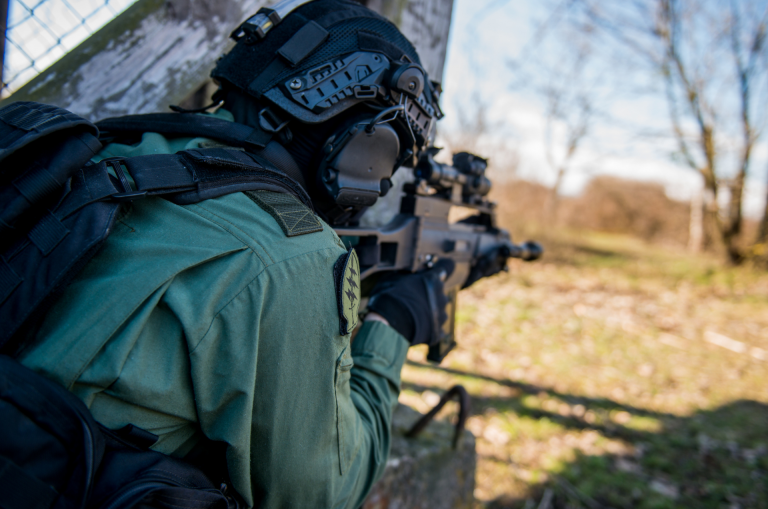
Introduction to Airsoft guns
Airsoft guns are replica firearms that shoot small plastic BBs or pellets. They are often used for recreational purposes such as target shooting, military simulations, and competitive gaming.
They are designed to mimic the appearance and function of real firearms but they use compressed gas or a spring-powered piston to shoot projectiles instead of gunpowder to make them safer.
In this article, we will take a detailed look at the types of Airsoft guns, how pellet speed is measured, various speed ranges, and legal restrictions. Let’s get started.
Understanding FPS: What it is and why it matters
To answer the question of How fast do Airsoft guns shoot, it is important to clarify what FPS is.
FPS stands for “feet per second” and it is a measure of the velocity or speed at which a projectile is propelled from the airsoft gun. In the case of airsoft guns, FPS is typically used to measure the speed of the BB as it exits the barrel.
The FPS rating can affect the accuracy, range, and power of the airsoft gun. For example, a higher FPS can result in a faster BB velocity and a longer effective range. Still, it may also decrease accuracy due to the increased likelihood of BB deviation. Conversely, a lower FPS can increase accuracy but decrease range and power.
Most airsoft fields have specific FPS limits that vary depending on the type of game being played, the age of the players, and the specific field rules. For example, indoor fields typically have lower FPS limits than outdoor fields, and some fields may have different limits for different types of guns (e.g., pistols vs. rifles).
Types of Airsoft guns and their speeds: Spring, gas, and electric:
There are three main types of airsoft guns: spring-powered, gas-powered, and electric-powered.
- Spring-powered: Spring-powered airsoft guns require manual cocking before each shot, which makes them relatively low-powered and inexpensive. Spring-powered airsoft guns typically have lower velocities than gas or electric-powered guns. The average FPS for spring-powered airsoft guns is typically in the range of 200 to 350 FPS.
- Gas-powered: Gas-powered airsoft guns use pressurized gas, such as CO2 or green gas, to propel BBs and are generally more powerful and realistic regarding recoil and sound. Gas-powered airsoft guns can have higher velocities than spring-powered guns, with many models capable of shooting over 500 FPS. However, the average FPS for gas-powered airsoft guns is typically in the range of 300 to 450 FPS.
- Electric-powered: Electric-powered airsoft guns use a rechargeable battery to power a motor that drives a piston, propelling BBs. Electric airsoft guns can be fully automatic and are generally the most reliable and consistent type of airsoft gun. Electric-powered airsoft guns generally have velocities in the middle range, with many models shooting in the range of 300 to 400 FPS. However, the FPS of higher-powered models may reach up to 550.
Some airsoft guns can be modified or upgraded to increase their FPS and overall performance. However, it is important to stay within legal limits and to use caution when making modifications to airsoft guns, as exceeding legal limits can result in safety hazards and legal consequences.
How fast do Airsoft guns shoot?
Factors that affect Airsoft gun velocity
Several factors can affect the velocity (FPS) of an airsoft gun. Some of the main factors include:
Spring tension: The spring inside an airsoft gun propels the BB out of the barrel. A stronger spring will create more tension and result in a higher FPS.
Air compression: Airsoft guns can use either a spring-powered system or a gas-powered system. In gas-powered guns, gas pressure is used to propel the BB. A gun with a higher gas pressure will result in a higher FPS.
The barrel length and bore diameter: The length and diameter of the barrel can affect the velocity of the BB as it travels through the barrel. A longer and narrower barrel can provide a higher FPS, while a shorter and wider barrel can result in a lower FPS.
BB weight: The weight of the BB being used can affect the FPS of an airsoft gun. Heavier BBs require more energy to propel and will result in a lower FPS compared to lighter BBs.
Legal Limits: FPS restrictions and regulations
The FPS limit for airsoft guns can vary depending on the location and type of event. In the United States, for example, the maximum FPS limit for airsoft guns used in competitive events is typically around 400 FPS. However, this can vary depending on the specific rules and regulations of the event.
Some countries, such as Canada and the United Kingdom, have stricter regulations on airsoft guns, with FPS limits as low as 328 FPS for some types of guns. It is important to note that exceeding the designated FPS limit for an airsoft gun can result in safety hazards and may lead to disqualification from events or legal consequences.
It is also important to use proper safety gear, such as eye protection and full-face masks, when using high-powered airsoft guns to minimize the risk of injury.
Conclusion
One of the most important aspects of airsoft guns is their velocity, which determines their overall performance. The velocity of airsoft guns can vary depending on various factors, including the type of gun, the weight of the BBs, and the source of power.
However, while airsoft guns are designed to be safer than real firearms, they can still pose risks if proper safety precautions are not followed. Wearing protective gear, such as full-face masks and eye protection, is crucial to prevent injuries, particularly when using high-powered airsoft guns.
By prioritizing safety and taking necessary precautions, airsoft enthusiasts can enjoy the thrill of shooting while minimizing potential risks.